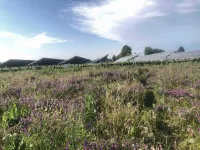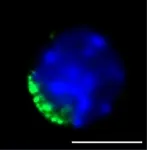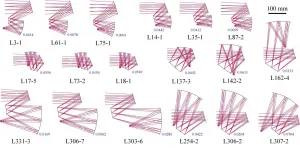(Press-News.org) CORVALLIS, Ore. - A new study by Oregon State University researchers found that shade provided by solar panels increased the abundance of flowers under the panels and delayed the timing of their bloom, both findings that could aid the agricultural community.
The study, believed to be the first that looked at the impact of solar panels on flowering plants and insects, has important implications for solar developers who manage the land under solar panels, as well as agriculture and pollinator health advocates who are seeking land for pollinator habitat restoration.
The findings, published in the journal Scientific Reports, are being released at a time when some states, such as Minnesota, North Carolina, Maryland, Vermont and Virginia, have developed statewide guidelines and incentives to promote pollinator-focused solar installations.
"The understudy of solar panels is typically managed to limit the growth of plants," said Maggie Graham, a faculty research assistant at Oregon State and lead author of the paper. "My thought coming into this research was can we flip that? Why not plant under solar arrays with something beneficial to the surrounding ecosystem, like flowers that attract pollinators? Would insects even use it? This study demonstrates that the answer is yes."
Pollinating insects aid in the reproduction of 75% of flowering plant species and 35% of crop species globally. In the United States, pollination services to agriculture are valued at $14 billion annually.
Habitat for pollinating insects is declining globally as a result of urbanization, agricultural intensification and land development. Changes in global climate can also cause shifts in habitat availability.
Meanwhile, solar photovoltaic installation in the U.S. has increased by an average of 48% per year over the past decade, and current capacity is expected to double again over the next five years, the researchers say.
The increased demand for solar panels leads to an interest in the field of agrivoltaics, where solar energy production is combined with agricultural production, such as planting agricultural crops or grazing animals, on the same land.
Graham works with Chad Higgins, an associate professor in Oregon State's College of Agricultural Sciences. Higgins recently published a paper that found co-developing land for both solar photovoltaic power and agriculture could provide 20% of total electricity generation in the United States with an investment of less than 1% of the annual U.S. budget.
Furthermore, wide-scale installation of agrivoltaic systems could lead to an annual reduction of 330,000 tons of carbon dioxide emissions in the U.S - the equivalent of 75,000 cars off the road per year - and the creation of more than 100,000 jobs in rural communities, while minimally impacting crop yield, Higgins found.
The new study led by Graham, who came to Oregon State after working at a nonprofit that focused on installing solar panels for low-income families, was conducted at the 45-acre Eagle Point Solar Plant in Jackson County, Oregon.
The research team collected data on pollinator and plant populations during seven, two-day sampling events from June through September 2019. Those corresponded with post-peak bloom times for flowers. Extending bloom times is important for pollinating insects because it provides them food later in the season, the researchers said.
The researchers collected data from 48 species of plants and 65 different insect species.
The study sites were broken into three categories: full shade plots under solar panels, partial shade plots under solar panels and full sun plots not under panels. Findings included:
Floral abundance was greatest in partial shade plots, where 4% more blooms were found compared to full sun and full shade plots.
The amount of flower species and the diversity of flowers didn't differ among the different plots.
An average of 3% more pollinating insects in partial shade and full sun plots than in full shade plots.
The amount of insect species and the diversity of insects was higher in partial shade and full sun than in full shade.
The number of insects per flower didn't differ among the different plots.
"Unused or underutilized lands below solar panels represent an opportunity to augment the expected decline of pollinator habitat," Graham said. "Near agricultural lands, this also has the potential to benefit the surrounding agricultural community and presents an avenue for future study. Solar developers, policy makers, agricultural communities and pollinator health advocates looking to maximize land-use efficiency, biodiversity and pollination services might want to consider pollinator habitat at solar photovoltaic sites as an option."
INFORMATION:
In addition to Graham and Higgins, other authors of the paper were: Serkan Ates, Andony Melathopoulos, Andrew Moldenke, Sandra DeBano and Lincoln Best, all of Oregon State.
Durham, NC - When leukemia strikes an older person, it is in part due to the aging of his or her hematopoietic stem cells (HSCs). These immature cells can develop into all types of blood cells, including white blood cells, red blood cells and platelets. As such, researchers have focused on rejuvenating HSCs as a way to treat leukemia.
A new study released today in STEM CELLS adds much to that level of knowledge by showing that the youthful function of rejuvenated HSCs upon transplantation depends in part on a young bone marrow "niche," which is the microenvironment surrounding stem cells that interacts with them to regulate their fate.
"The information revealed by our study tells us that the influence of this niche ...
Ancient clues, in the shape of fossils and archaeological evidence of varying quality scattered across Australia, have formed the basis of several hypotheses about the fate of megafauna that vanished about 42,000 years ago from the ancient continent of Sahul, comprising mainland Australia, Tasmania, New Guinea and neighbouring islands.
There is a growing consensus that multiple factors were at play, including climate change, the impact of people on the environment, and access to freshwater sources.
Now, research led by Professor Corey Bradshaw of Flinders University and the Australian Research Council Centre of Excellence of Australian Biodiversity and Heritage (CABAH) has used sophisticated mathematical modelling to assess how susceptible different species were to extinction - and what ...
April 13th, 2021, Washington, D.C. - The severe health and economic impacts of the COVID-19 pandemic have disrupted food systems and upended livelihoods. Yet pandemic responses have demonstrated the power of well-crafted policies to blunt the impact of major shocks while laying the groundwork for stronger, more resilient food systems, according to the 2021 Global Food Policy Report, released today by the International Food Policy Research Institute (IFPRI). The report provides lessons drawn from the current crisis that can help us transform food systems to reduce the impact of the ongoing pandemic, better prepare for future shocks, and address longstanding weaknesses and inequalities.
"We have known ...
In the early time of optical design, people have to be proficient in aberration theory and perform a huge amount of numerical calculations, and thus mathematical skills and talents are very important. The emergence of electronic computers has freed people from heavy calculation tasks, and realized fast real ray tracing and been able to solve complex aberration equations. Since then, the application and development of optimization algorithms and optical design software have greatly improved the speed and effect of optical design. However, optical design still requires to solve or find an initial solution as the starting point of optimization, which will greatly determine the final result of optimization. Moreover, optimization is essentially ...
The top priority in the field of transplantation is to ensure that donor organs are allocated to the patients with the greatest need.
In a large-scale joint international project conducted by the Medical University of Vienna and the Mayo Clinic in Rochester (USA), researchers from the Department of General Surgery and the Division of Gastroenterology and Hepatology of MedUni Vienna's Department of Medicine III, have made a significant step forward to improve prediction of survival on the waiting list for liver transplantation by including additional laboratory parameters.
Donor ...
In recent years the boom in streaming platforms and video on demand services has led to disruption in audiences, representing a difficulty when measuring the number of viewers of the content distributed by these platforms.
This new situation has not only altered the traditional television and film viewing model, but also has impacted the advertising market, which is a fundamental factor in funding and the business of audiovisual entertainment.
In this context, real and objective audience measurement (which is not influenced by the interests of the platforms) has become a key objective; it is fundamental to obtain real-time data on the reach of each production ...
When trees die during a period of drought, they die of thirst. Researchers from the University of Basel have demonstrated in a field study that a rapid collapse in the hydraulic system is responsible for tree death. And they found out that the trees possibly die more rapidly than previously thought.
The heatwave of summer 2018 was an exceptional situation - both for nature and for research. Although admittedly hard on our native woods, it also presented an opportunity for researchers at the University of Basel to closely study the reaction of trees to this weather phenomenon.
The research group led by Professor Ansgar Kahmen had already set up a research area in the Basel-Landschaft municipality of Hölstein the previous year. Their aim was to study the tree ...
Misinformation in public debates about scientific issues such as vaccinations and climate change can be found all over the internet, especially on social media. In a new study, Sara K. Yeo, associate professor of communication at the University of Utah, examines why it's so difficult to detect science misinformation and suggests that using humor may help combat the issue.
In the article, published in Proceedings of National Academics of Sciences, Yeo and her colleague Meaghan McKasy, assistant professor of communication at Utah Valley University, argue that limited science and media literacy combined with structural constraints such as fewer ...
Low-dimensional colloidal quantum dots (CQD) have attracted significant attention because of their unique structures, extraordinary optical properties, and low-cost preparation processes. Since its first synthesis in the 1990s, motivation to realize high-performance low-cost CQD micro-/nanolasers have been a driving force for more than three decades. However, the low packing density, inefficient coupling of CQD with optical cavities, and the poor thermal stability of miniaturized complex systems make it challenging to achieve practical CQD micro-/nanolasers, especially to combine the continuous working ...
Osaka, Japan - Fluorescence spectroscopy is indispensable in biomedical diagnostics. One can think of turning on fluorescence as turning on a flashlight in a dark room. A diagnostic assay can be designed to label, for example, a specific molecule of DNA with a fluorescent probe. If that specific molecule of DNA is present, you see fluorescence or a change in the fluorescence.
Sometimes an otherwise fluorescent molecule stops emitting light for a brief period of time. This is called fluorescence blinking, which can make it difficult to detect biomolecules at the ultralow concentrations ...





